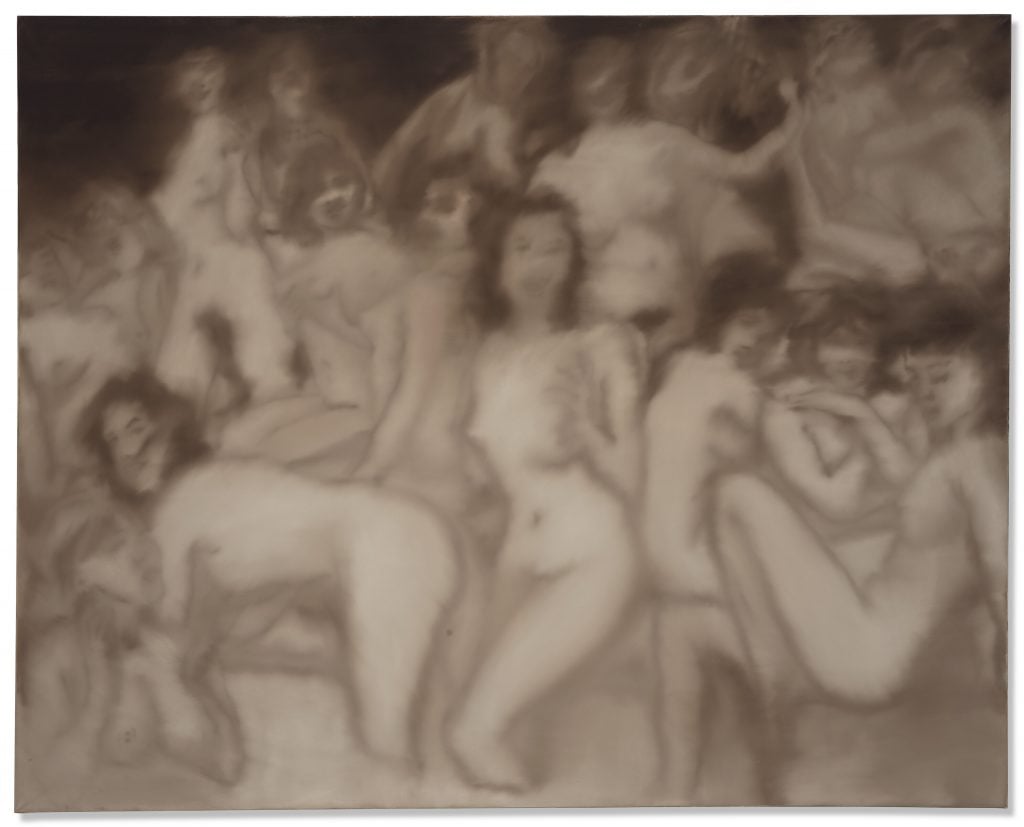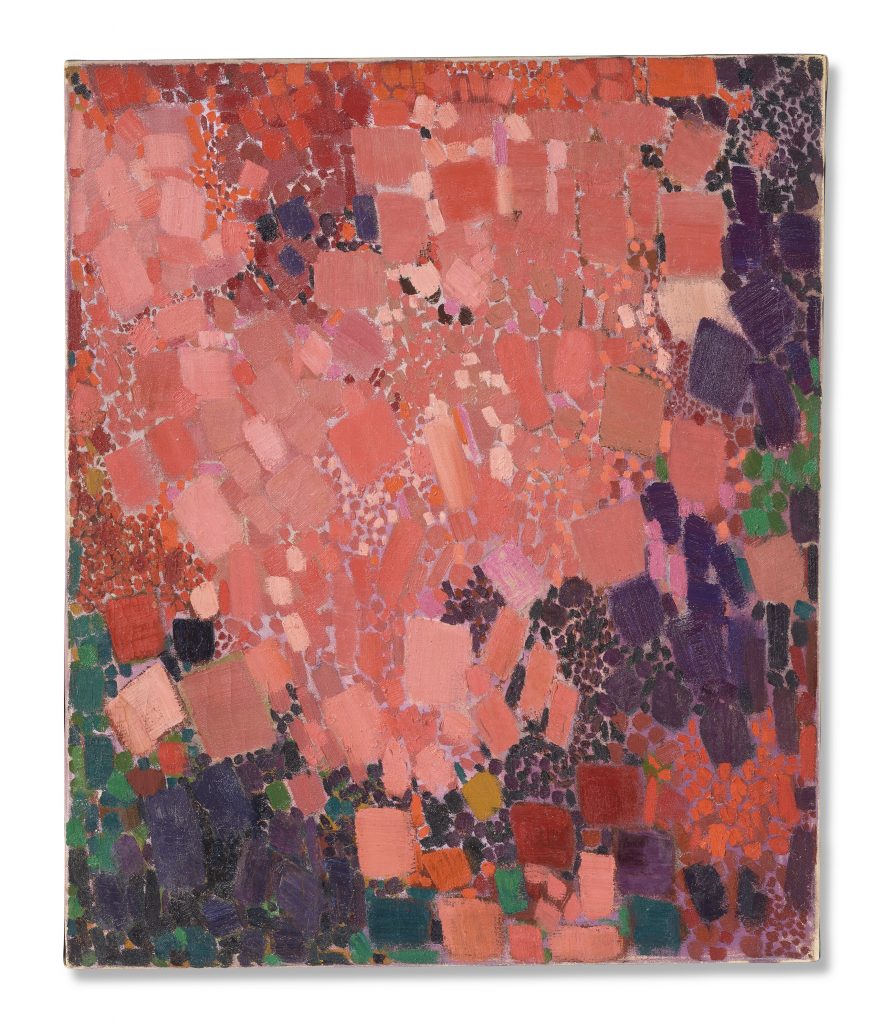The Back Room
The Back Room: Wellness Check
This week: May auction numbers decoded, the fresh faces of the Guggenheim Young Collectors Coalition, and much more.

This week: May auction numbers decoded, the fresh faces of the Guggenheim Young Collectors Coalition, and much more.

Artnet News

Every Friday, Artnet News Pro members get exclusive access to the Back Room, our lively recap funneling only the week’s must-know intel into a nimble read you’ll actually enjoy.
This week in the Back Room: crunching the May auction numbers, the Lisa Schiff saga continues, Lynne Drexler keeps rising from beyond the grave, and more—all in an 8-minute read (2,124 words).
_____________________________

Gerhard Richter, Badende (1967). Courtesy of Christie’s.
Tim here. After two weeks’ worth of extremely uneven auctions in New York, a paradox has emerged.
On one hand, most of the trade agrees that the market finally cooled off this spring. On the other hand, the more people I talk to one-on-one, the less certain I am that anyone feels they understand in detail which segments cooled off, let alone what it means going forward (beyond the obvious, anyway).
To counteract the art world’s tendency to rocket to emotional extremes, I dove deep into auction metrics to try to separate the market signals from the unusual amount of noise this spring. Below are glosses on three of my five takeaways. (You’ll have to click through for the rest.)
Is it reductive to judge the performance of any individual sale or seasonal auction cycle with one statistic? Sure. But comparing the hammer total to the total presale estimate (which excludes fees) is still an exceptionally instructive exercise for anyone who wants an at-a-glance gauge of the market.
By my calculations, the nine art evening sales from Christie’s, Sotheby’s, and Phillips generated a hammer total of slightly over $1.23 billion against a total presale estimate of $1.28 billion. To be even more specific, the houses collectively underperformed their low expectations by $48.3 million.
Relative to more than $1.2 billion worth of sales, $48.3 million is not that far from a rounding error. That means that, together, the houses performed more or less right up to their low estimates.
So why is the mood in the aftermath of the sales so downbeat? I suspect the sequence of the auctions had a lot to do with it. The hammer total surpassed the presale low estimate in each of the first four evening sales. Then, each of the last five evening sales failed to hit that metric.
The Takeaway: This uninterrupted peak-to-valley movement would be one thing if some business-critical news had broken during the intermission separating Sotheby’s Mo Ostin sale from its modern evening sale—say, the collapse of a systemically important financial institution, or confirmation that Congress will fail to raise the debt ceiling.
Nothing of that nature actually happened, though. That makes it a fascinating little experiment in market psychology to consider how differently the past two weeks of evening sales might have been perceived if the four overperforming auctions would have followed the five underperforming ones rather than the inverse.
Across the nine art evening sales at Christie’s, Sotheby’s and Phillips, the houses made direct financial guarantees for 87 lots with an aggregate low estimate of $730.9 million. That amount equates to 57.1 percent of the total presale low estimate of $1.28 billion.
Yet the Big Three farmed out the overwhelming majority of the risk to third-party financiers before showtime. In all, 85 lots carried irrevocable bids adding up to $663.5 million—just shy of 52 percent of the total presale low estimate.
In other words, of the $730.9 million worth of guarantees made by Christie’s, Sotheby’s, and Phillips, the houses thought it wise to reduce their direct exposure to a measly $67.4 million via irrevocable bidders.
The Takeaway: The volume of financial engineering this season was simultaneously notable and business as usual for the Big Three by this point in the 21st century. A house can only sell what it can manage to consign, and offering financial guarantees is simply part and parcel to making the most compelling pitch to the owners of valuable artwork, all of whom are probably being pitched by multiple houses.
In this sense, the real signal of performance anxiety this spring was Christie’s, Sotheby’s, and Phillips’s decision to offloaded so much of their risk via third parties. Shelling out house guarantees was, in most cases, probably a necessity; bringing in irrevocable bidders was not.
That the Big Three did the latter at such grand scale suggests to me that internal expectations were even more conservative than the public estimates let on.
One of the oldest mantras in the art market is that most collectors tend to respond to instability by redirecting their money from works by less proven artists to works by established greats who can be trusted as stores of long-term value.
My quibble? There seems to be almost no evidence whatsoever that it actually happened during the past two weeks’ evening sales.
Look at the auctions dedicated to young artists. Christie’s 21st century evening sale boasted a hammer total 31.6 percent higher by value than its presale low estimate, partly thanks to works by ultra-contemporary artists Louis Fratino, Vojtěch Kovařík (in his first evening sale), Danielle Mckinney (ditto), Emma Webster, and Robin F. Williams all selling on bids surpassing their high estimates. (“Ultra-contemporary” is Artnet’s in-house designation for artists born in 1975 or later.)
Sotheby’s The Now auction fared considerably worse by the numbers alone, but the main weakness was the withdrawal of Yoshitomo Nara’s Haze Days, a 25-year-old painting by a 63-year-old artist. Set that aside, and the youngest artist to have their work bought in or withdrawn from the auction was Wade Guyton, who turns 51 this year.
Meanwhile, of the 19 The Now lots to sell, six by ultra-contemporary artists were bid up beyond their high presale expectations. The artists in question were Justin Caguiat, Njideka Akunyili-Crosby, Jadé Fadojutimi, Julien Nguyen, Angel Otero, and Portia Zvavahera.
But the starkest manifestation of the divide was Christie’s evening auction of the Gerald Fineberg collection.
The sale was chock full of postwar and contemporary greats whose legacies are already secure. Yet the response from bidders, according to my colleague Katya Kazakina, was that “at times, the packed Rockefeller Center salesroom felt like a fire sale.” When it was all done, the hammer total ($124.7 million) landed almost 25 percent beneath the presale low estimate of $163 million.
The Takeaway: It’s true that plenty of canonical artists performed well in this auction cycle, and that ultra-contemporary talent wasn’t bulletproof as a category. Just don’t let anyone convince you that demand for fresh-faced artists is about to vanish like a mirage in the desert.
The contours of the market at large are most definitely shifting, but we’ll all need more than generalities about birthdates and institutional track records to guide us through what comes next.
___________________________________________________________
Even for seasoned art pros, storytelling plays a strong role in shaping perceptions of the market’s overall health. This is now especially true when it comes to major auction cycles, which offer too much information for most people to comb through, let alone draw fine-grained conclusions from.
But in a season of mixed results, this tendency also means that the dominant narrative of events can be based on feelings more than facts.
The disconnect between the data and the post-auction chatter leaves me convinced that a nontrivial proportion of the art trade is at least flirting with making this mistake after the May sales.
Yes, the market softened. But there’s little evidence that it’s on the verge of the type of collapse that some people are speculating about. What’s more, the weakest points aren’t necessarily the ones that conventional wisdom would have us believe. Stay vigilant.
_________________________________________________________
The latest Wet Paint tracks the fresh-faced movers and shakers in the Guggenheim Young Collectors Coalition, then delves into a string of anti-woke tweets by Bart Drenth, global managing director of TEFAF…
Here’s what else made a mark around the industry since last Friday morning…
Art Fairs
Auction Houses
Galleries
Institutions
Tech and Legal News
_________________________________________________________
“Eventually, Defendants’ management of Plaintiffs’ collections was so complete and longstanding that Plaintiffs came to completely rely on and trust Schiff and her entities; it never occurred to them that Schiff would steal from them.”
—excerpt from the second lawsuit filed against embattled art advisor Lisa Schiff and her companies by former client and friend Candace Barasch. Barasch claims that Schiff owes her at least $2.5 million plus interest and damages for a series of art purchases on her behalf that were only partially completed or never completed. (Artnet News)

Lynne Drexler, Summer Blossom (1962). Courtesy of Christie’s Images, Ltd.
____________________________________________________________
Date: 1962
_____________________________________________________________
Seller: The estate of Gerald Fineberg
_____________________________________________________________
Estimate: $150,000 to $200,000
_____________________________________________________________
Sold For: $1.4 million
_____________________________________________________________
Sold At: Christie’s “A Century of Art: The Gerald Fineberg Collection, Part II”
One of the last works acquired by Gerald Fineberg, who died in December 2022, this small canvas has a sumptuous palette and tight composition of cascading brushstrokes. The final price represented the second-highest result ever for the reclusive painter, whose oeuvre is being reexamined and whose market has been surging since the pandemic began.
Summer Blossom was the most expensive of the 14 lots by Drexler on the block in New York this month. Two years ago, the painting was included in “Explosions of Color | Dimensions of Sound: The Art of Lynne Mapp Drexler” at Jody Klotz Fine Art in Abilene, Texas. Printed on the cover of the show’s catalog, it had an asking price of just under $150,000, according to Klotz, who played an important role in Drexler’s recent market resurgence. She paid $75,000 for the artist’s Daffodil Gloucester in May 2021, the highest price for a Drexler piece at auction (it was estimated at $8,000 to $12,000).
Reluctant to sell the best works in her show, Klotz “decided to put prices that were unprecedented,” she said. “I had to scrape and search to make this show.” But she did end up selling the painting to an Italian collector, through a New York art adviser. Fineberg bought it about a year later; the painting was installed in his bathroom to brighten up his final days.
—Katya Kazakina
________________________________________________________